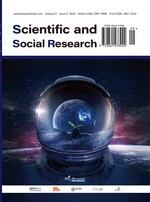Abstract
In recent years, the importance of blending traditional methane gas with alternative fuels in combustion to reduce emissions has gained increasing recognition. Existing literature has demonstrated the successful operation of ammonia and hydrogen as fuels in diesel engines. However, there is still insufficient information regarding the combustion of methane in combination with ammonia and hydrogen. This paper investigates the effects of replacing ammonia with hydrogen in blends consisting of 70% CH4 and 30% NH3, with hydrogen substitution levels of 0%, 10%, 30%, 50%, 70%, and 90%. The simulation was carried out using the SST k-ω turbulence model and steady diffusion flamelet model. Calculations using Okafor-mech to predict the emission characteristics were also attempted to determine concentration values more accurately. Results show that as the proportion of hydrogen in the blended fuel increases, the maximum temperature rises by 29.28 K. There is an increase in emissions of carbon dioxide and carbon monoxide, while nitrogen oxide emissions decrease.
References
Risco-Bravo A, Varela C, Bartels J, et al., 2024, From Green Hydrogen to Electricity: A Review on Recent Advances, Challenges, and Opportunities on Power-to-hydrogen-to-power Systems. Renewable and Sustainable Energy Reviews, 189(50): 113930. https://doi.org/10.1016/j.rser.2023.113930
Department for Energy Security and Net Zero, 2022, Net Zero Strategy: Build Back Greener. Accessed on August 28, 2024, https://www.gov.uk/government/publications/net-zero-strategy
Tian J, Zhou S, Wang Y, 2023, Assessing the Technical and Economic Potential of Wind and Solar Energy in China—A Provincial-scale Analysis. Environmental Impact Assessment Review, 2023(102): 107161. https://doi.org/10.1016/j.eiar.2023.107161
Valera-Medina A, Amer-Hatem F, Azad AK, et al., 2021, Review on Ammonia as a Potential Fuel: From Synthesis to Economics. Energy & Fuels 2021, 35(9): 6964–7029. https://doi.org/10.1021/acs.energyfuels.0c03685
Valera-Medina A, Xiao H, Owen-Jones M, et al., 2018, Ammonia for Power. Progress in Energy and Combustion Science, 69(2): 63–102. https://doi.org/10.1016/j.pecs.2018.07.001
Zamfirescu C, Dincer I, 2008, Using Ammonia as a Sustainable Fuel. Journal of Power Sources, 185(1): 459–465. https://doi.org/10.1016/j.jpowsour.2008.02.097
Haputhanthri SO, Maxwell TT, Fleming J, et al., 2015, Ammonia and Gasoline Fuel Blends for Spark Ignited Internal Combustion Engines. Journal of Energy Resources Technology, 137(6): 062201. https://doi.org/10.1115/1.4030443
Haputhanthri SO, Maxwell TT, Fleming J, et al., 2015, Ammonia and Gasoline Fuel Blends for Spark Ignited Internal Combustion Engines. Journal of Energy Resources Technology, 137(6): 062201. https://doi.org/10.4271/2019-24-0137
Kang L, Pan W, Zhang J, et al., 2023, A Review on Ammonia Blends Combustion for Industrial Applications. Fuel, 332(2): 126150. https://doi.org/10.1016/j.fuel.2022.126150
Valera-Medina A, Gutesa M, Xiao H, et al., 2019, Premixed Ammonia/hydrogen Swirl Combustion under Rich Fuel Conditions for Gas Turbines Operation. International Journal of Hydrogen Energy, 44(16): 8615–8626. https://doi.org/10.1016/j.ijhydene.2019.02.041
Cellek MS, 2022, The Decreasing Effect of Ammonia Enrichment on the Combustion Emission of Hydrogen, Methane, and Propane Fuels. International Journal of Hydrogen Energy, 47(45): 19916–19934. https://doi.org/10.1016/j.ijhydene.2021.11.241
Gotama G, Hayakawa A, Okafor E, et al., 2022, Measurement of the Laminar Burning Velocity and Kinetics Study of the Importance of the Hydrogen Recovery Mechanism of Ammonia/hydrogen/air Premixed Flames. Combustion and Flame, 2022(236): 111753. https://doi.org/10.1016/j.combustflame.2021.111753
Han X, Wang Z, Costa M, et al., 2019, Experimental and Kinetic Modeling Study of Laminar Burning Velocities of NH3/air, NH3/H2/air, NH3/CO/air and NH3/CH4/air Premixed Flames. Combustion and Flame, 2019(206): 214–226.
Wang D, Ji C, Wang S, et al., 2021, Numerical Study of the Premixed Ammonia-hydrogen Combustion under Engine-relevant Conditions. International Journal of Hydrogen Energy, 46(2): 2667–2683.
Mashruk S, Vigueras-Zuniga MO, Tejeda-del-Cueto ME, et al., 2022, Combustion Features of CH4/NH3/H2 Ternary Blends. International Journal of Hydrogen Energy, 47(70): 30315–30327. https://doi.org/10.1016/j.ijhydene.2022.03.254
Xiao H, Valera-Medina A, Bowen PJ, 2017, Study on Premixed Combustion Characteristics of Co-firing Ammonia/methane Fuels. Energy, 140(1): 125–135. https://doi.org/10.1016/j.energy.2017.08.077
Okafor EC, Naito Y, Colson S, et al., 2018, Experimental and Numerical Study of the Laminar Burning Velocity of CH4–NH3–air Premixed Flames. Combustion and Flame, 2018(187): 185–198 + 201.
